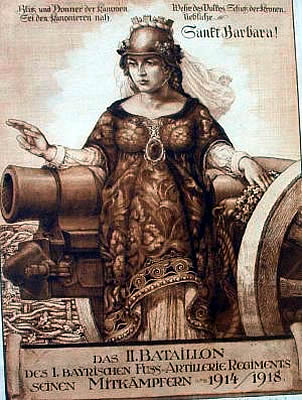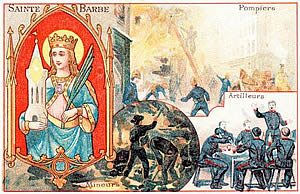| Raphael's
Masterpieces |
|
Saint
Barbara |
||
|
Who
was Saint Barbara? |
Bio
St. Barbara from Catholic Encyclopedia |
Bio
St. Barbara from Wikipedia |
||
Saint Barbara - catholic patron saint of thunder and lighting |
Prayer
to Saint Barbara |
|||
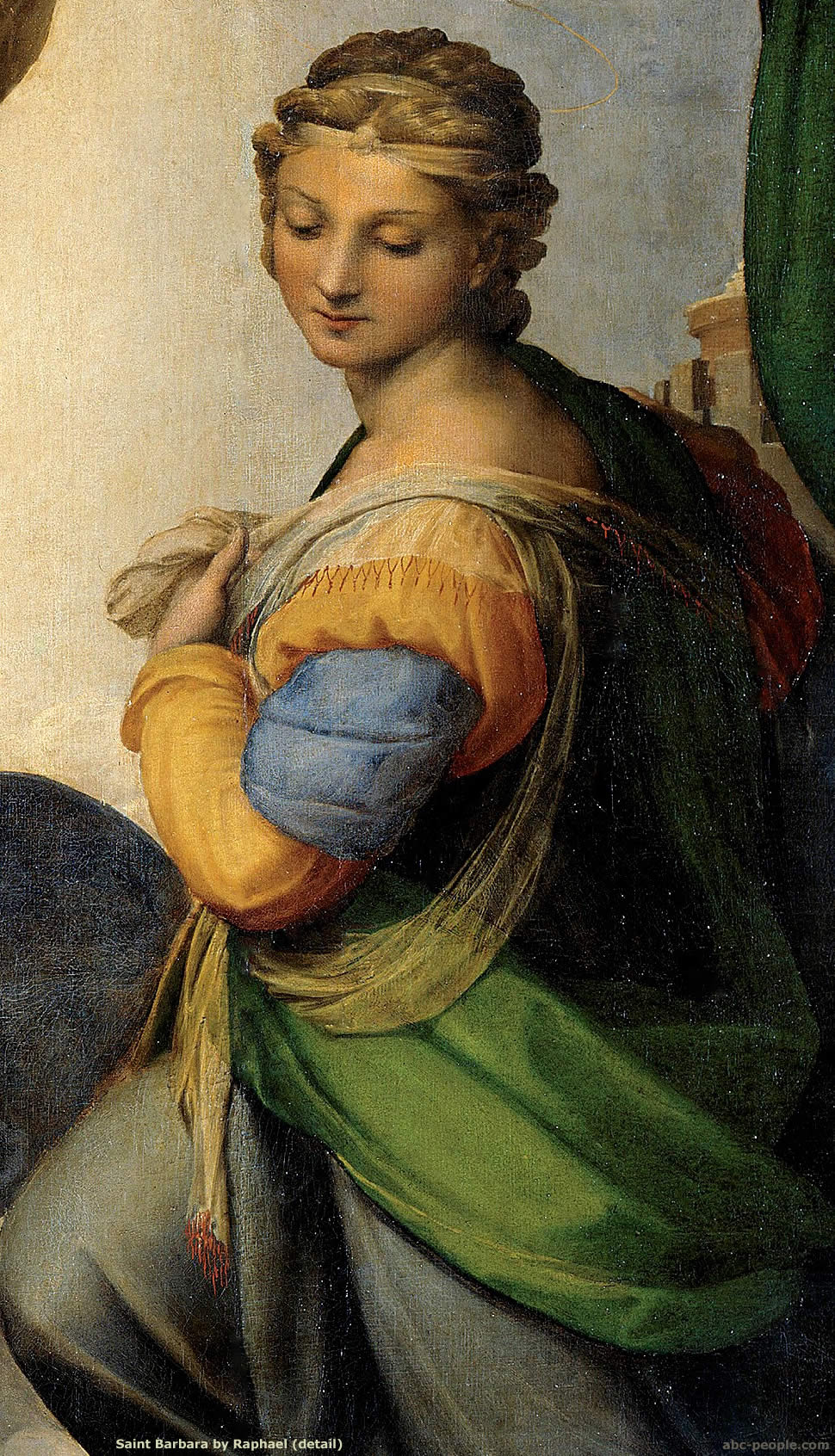 |
|||
| Raphael
Sanzio (Santi) Oil
on canvas |
|||
|
| |
Who
was Saint Barbara? |
||
The Holy Great Martyr Barbara lived and suffered during the reign of the emperor Maximian (305-311). Her father, the pagan Dioscorus, was a rich and illustrious man in the Syrian city of Heliopolis. After the death of his wife, he devoted himself to his only daughter. Seeing Barbara’s extraordinary beauty, Dioscorus decided to hide her from the eyes of strangers. Therefore, he built a tower for Barbara, where only her pagan teachers were allowed to see her. From the tower there was a view of hills stretching into the distance. By day, she was able to gaze upon the wooded hills, the swiftly flowing rivers, and the meadows covered with a mottled blanket of flowers; by night the harmonious and majestic vault of the heavens twinkled and provided a spectacle of inexpressible beauty. Soon the virgin began to ask herself questions about the First Cause and Creator of so harmonious and splendid a world. Gradually, she became convinced that the soulless idols were merely the work of human hands. Although her father and teachers offered them worship, she realized that the idols could not have made the surrounding world. The desire to know the true God so consumed her soul that Barbara decided to devote all her life to this goal, and to spend her life in virginity. The fame of her beauty spread throughout the city, and many sought her hand in marriage. But despite the entreaties of her father, she refused all of them. Barbara warned her father that his persistence might end tragically and separate them forever. Dioscorus decided that the temperament of his daughter had been affected by her life of seclusion. He therefore permitted her to leave the tower and gave her full freedom in her choice of friends and acquaintances. Thus Barbara met young Christian maidens in the city, and they taught her about the Creator of the world, about the Trinity, and about the Divine Logos. Through the Providence of God, a priest arrived in Heliopolis from Alexandria disguised as a merchant. After instructing her in the mysteries of the Christian Faith, he baptized Barbara, then returned to his own country. |
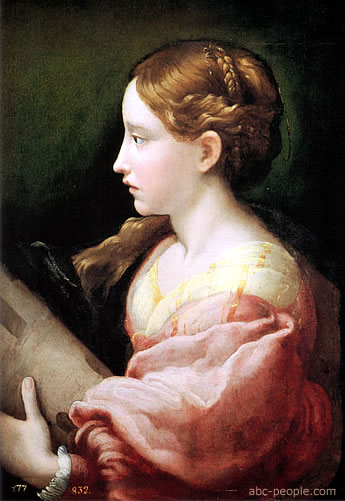 Parmigianino Saint Barbara c.1522. Oil on panel, 48 x 39 cm Museo del Prado, Madrid, Spain |
|
During this time, a luxurious bathhouse was being built at the house of Dioscorus. By his orders, the workers prepared to put two windows on the south side. But Barbara, taking advantage of her father’s absence, asked them to make a third window, thereby forming a Trinity of light. On one of the walls of the bath-house Barbara traced a cross with her finger. The cross was deeply etched into the marble, as if by an iron instrument. Later, her footprints were imprinted on the stone steps of the bathhouse. The water of the bathhouse had great healing power. St. Simeon Metaphrastes (November 9) compared the bathhouse to the stream of Jordan and the Pool of Siloam, because by God’s power, many miracles took place there. When Dioscorus returned and expressed dissatisfaction about the change in his building plans, his daughter told him about how she had come to know the Triune God, about the saving power of the Son of God, and about the futility of worshipping idols. Dioscorus went into a rage, grabbed a sword and was on the point of striking her with it. The holy virgin fled from her father, and he rushed after her in pursuit. His way became blocked by a hill, which opened up and concealed the saint in a crevice. On the other side of the crevice was an entrance leading upwards. St Barbara managed then to conceal herself in a cave on the opposite slope of the hill. |
After a long and fruitless search for his daughter, Dioscorus saw two shepherds on the hill. One of them showed him the cave where the saint had hidden. Dioscorus beat his daughter terribly, and then placed her under guard and tried to wear her down with hunger. Finally he handed her over to the prefect of the city, named Martianus. They beat St. Barbara fiercely: they struck her with rawhide, and rubbed her wounds with a hair cloth to increase her pain. By night, St. Barbara prayed fervently to her Heavenly Bridegroom, and the Savior Himself appeared and healed her wounds. Then they subjected the saint to new, and even more frightful torments. In the crowd where the martyr was tortured was the virtuous Christian woman Juliana, an inhabitant of Heliopolis. Her heart was filled with sympathy for the voluntary martyrdom of the beautiful and illustrious maiden. Juliana also wanted to suffer for Christ. She began to denounce the torturers in a loud voice, and they seized her. Both martyrs were tortured for a long time. Their bodies were raked and wounded with hooks, and then they were led naked through the city amidst derision and jeers. Through the prayers of St. Barbara, the Lord sent an angel who covered the nakedness of the holy martyrs with a splendid robe. Then the steadfast confessors of Christ, Ss. Barbara and Juliana, were beheaded. Dioscorus himself executed St. Barbara. The wrath of God was not slow to punish both torturers, Martianus and Dioscorus. They were killed after being struck by lightning. |
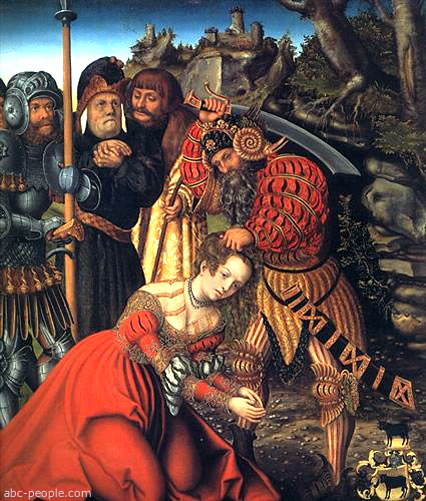 Lucas Cranach the Elder The Martyrdom of St. Barbara c.1510, Germany. Oil in wood, 153 x 138 cm Metropolitan Museum of Art, New York City |
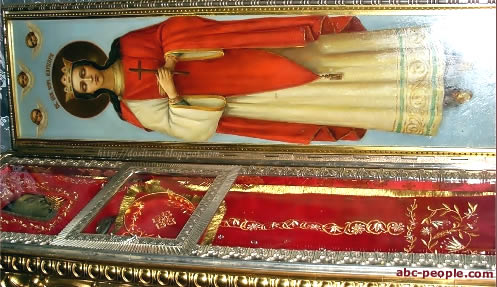 Details of the urn containing the body of the Holy exposed to the veneration of the faithful. Orthodox Cathedral of St. Vladimir, Kiev (Ukraine) |
In the sixth century the relics of the holy Great Martyr Barbara were transferred to Constantinople. Six hundred years later, they were transferred to Kiev (July 11) by Barbara, the daughter of the Byzantine Emperor Alexius Comnenos, who married the Russian prince Michael Izyaslavich. They rest even now at Kiev’s St Vladimir cathedral, where an Akathist to the saint is served each Tuesday. Many pious Orthodox Christians are in the habit of chanting the troparion of St. Barbara each day, recalling the Savior’s promise to her that those who remembered her and her sufferings would be preserved from a sudden, unexpected death, and would not depart this life without benefit of the Holy Mysteries of Christ. St. Barbara is commemorated on December 4. |
St.
Barbara from Catholic Encyclopedia |
||
Virgin and Martyr. There is no reference to St. Barbara contained in the authentic early historical authorities for Christian antiquity, neither does her name appear in the original recension of St. Jerome's martyrology. Veneration of the saint was common, however, from the seventh century. At about this date there were in existence legendary Acts of her martyrdom which were inserted in the collection of Symeon Metaphrastes and were used as well by the authors (Ado, Usuard, etc.) of the enlarged martyrologies composed during the ninth century in Western Europe. According to these narratives, which are essentially the same, Barbara was the daughter of a rich heathen named Dioscorus. She was carefully guarded by her father who kept her shut up in a tower in order to preserve her from the outside world. An offer of marriage which was received through him she rejected. Before going on a journey her father commanded that a bath-house be erected for her use near her dwelling, and during his absence Barbara had three windows put in it, as a symbol of the Holy Trinity, instead of the two originally intended. When her father returned she acknowledged herself to be a Christian; upon this she was ill-treated by him and dragged before the prefect of the province, Martinianus, who had her cruelly tortured and finally condemned her to death by beheading. The father himself carried out the death-sentence, but in punishment for this he was struck by lightning on the way home and his body consumed. Another Christian named Juliana suffered the death of a martyr along with Barbara. A pious man called Valentinus buried the bodies of the saints; at this grave the sick were healed and the pilgrims who came to pray received aid and consolation. The emperor in whose reign the martyrdom is placed is sometimes called Maximinus and sometimes Maximianus; owing to the purely legendary character of the accounts of the martyrdom, there is no good basis for the investigations made at an earlier date in order to ascertain whether Maximinus Thrax (235-238) or Maximinus Daza (of the Diocletian persecutions), is meant. The traditions vary as to the place of martyrdom, two different opinions being expressed: Symeon Metaphrastes and the Latin legend given by Mombritius makes Heliopolis in Egypt the site of the martyrdom, while other accounts, to which Baronius ascribes more weight, give Nicomedia. In the "Martyrologium Romanum parvum" (about 700), the oldest martyrology of the Latin Church in which her name occurs, it is said: "In Tuscia Barbarae virginis et martyris", a statement repeated by Ado and others, while later additions of the martyrologies of St. Jerome and Bede say "Romae Barbarae virginis" or "apud Antiochiam passio S. Barbarae virg.". These various statements prove, however, only the local adaptation of the veneration of the saintly martyr concerning whom there is no genuine historical tradition. It is certain that before the ninth century she was publicly venerated both in the East and in the West, and that she was very popular with the Christian populace. The legend that her father was struck by lightning caused her, probably, to be regarded by the common people as the patron saint in time of danger from thunder-storms and fire, and later by analogy, as the protector of artillerymen and miners. She was also called upon as intercessor to assure the receiving of the Sacraments of Penance and Holy Eucharist at the hour of death. An occurrence of the year 1448 did much to further the spread of the veneration of the saint. A man named Henry Kock was nearly burnt to death in a fire at Gorkum; he called on St. Barbara, to whom he had always shown great devotion. She aided him to escape from the burning house and kept him alive until he could receive the last sacraments. A similar circumstance is related in an addition to the "Legenda aurea". In the Greek and present Roman calendars the feast of St. Barbara falls on 4 December, while the martyrologies of the ninth century, with the exception of Rabanus Maurus, place it on 16 December. St. Barbara has often been depicted in art; she is represented standing in a tower with three windows, carrying the palm of a martyr in her hand; often also she holds a chalice and sacramental wafer; sometimes cannon are displayed near her. |
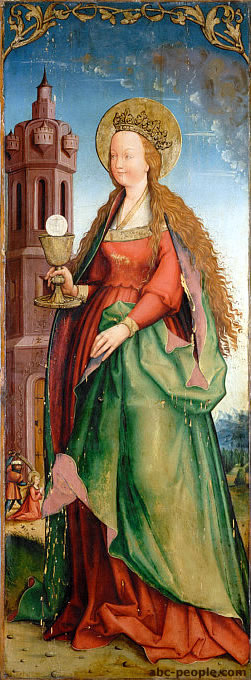 Wilhelm Ziegler Saints Barbara 1524 |
|
SAINT
BARBARA (SANTA BARBARA)- Saint
Barbara, a Virgin Martyr, is the patron saint of firefighters, soldiers,
prisoners, stone masons, those who have dangerous professions, construction
workers, builders, mathematicians, and the city of Santa Barbara,
California. She died by the sword, but her killers were struck down
by lightning, so she is often called on for protection from lightning
and for protection from violent and unpredictable death. She is
one of the Fourteen Holy Helpers. Her feast day is December 4th. When her father finally found a suitable husband for Barbara, she admitted to being a Christian and refused the marriage. She escaped from the tower and hid out among some shepherds, but was re-captured. The prefect of the province, Martinianus, also called the procounsel Marcian, ordered her to be paraded naked though the town. A fog came up suddenly and hid her from the crowd. He then ordered her to be tortured with the flames from burning torches, and condemned to death. The torches did not burn her, so on December 4th, 306, her father carried out the death sentence by beheading her. On his way home, he was miraculously struck by lightning and killed, in what appeared to be an act of divine retribution. Because there have been doubts about the historical accuracy of this story, Saint Barbara was removed from the Catholic liturgical calendar in 1969. However, like Saint Christopher and Saint Expedite, who were similarly "desainted" at the same time, her popularity continues unabated. The iconography of Saint Barbara generally shows her dressed in white and red. The sky may be dark and foggy, with jagged flasshes of lightning above. Often the tower in which she was kept captive is depicted the background, but in some images, she holds a small model of a tower in her hands or wears a crown which mimics the crenelated top of a stone fortress-tower. In addition to the tower, images associated with Saint Barbara include the sword with which she was beheaded, a chalice, the palm branch of her martyrdom, and the lilies of virginity, A little plant bearing white daisy-like flowers - either Feverfew or Life Everlasting -often blooms at her feet. In
Syria, Lebanon and Palestine, among Arab Christians, Saint Barbara's
Day is often celebrated with offerings of white barley and red pomegranate
seeds, sweetened with raisins, anise, and sugar. |
Saint
Barbara Saint
Barbara, Feast Day December 4, known in the Eastern Orthodox Church
as the Great Martyr Barbara, was an early Christian saint and martyr.
Accounts place her in the 3rd century in Nicomedia, present-day
Turkey or in Heliopolis of Phoenicia, present-day Baalbek, Lebanon.
There is no reference to her in the authentic early Christian writings
nor in the original recension of Saint Jerome's martyrology. Her
name can be traced to the 7th century, and veneration of her was
common, especially in the East, from the 9th century. Because of
doubts about the historicity of her legend, she was removed from
the General Roman Calendar in the 1969 revision, though not from
the Catholic Church's list of saints. Life According
to the hagiographies, Barbara, the daughter of a rich pagan named
Dioscorus, was carefully guarded by her father who kept her locked
up in a tower in order to preserve her from the outside world. Having
secretly become a Christian, she rejected an offer of marriage that
she received through him. Dragged
before the prefect of the province, Martinianus, who had her cruelly
tortured, Barbara held true to her faith. During the night, the
dark prison was bathed in light and new miracles occurred. Every
morning her wounds were healed. Torches that were to be used to
burn her went out as soon as they came near her. Finally she was
condemned to death by beheading. Her father himself carried out
the death-sentence. However, as punishment for this, he was struck
by lightning on the way home and his body was consumed by flame.
Barbara was buried by a Christian, Valentinus, and her tomb became
the site of miracles. |
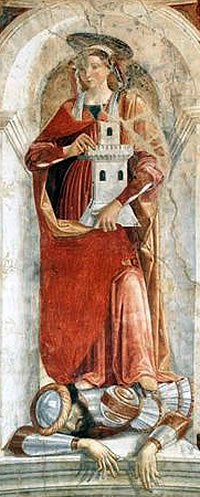 Domenico Ghirlandaio St. Barbara fresco, c.1471 Parish Church, Grandcamp, France |
| |
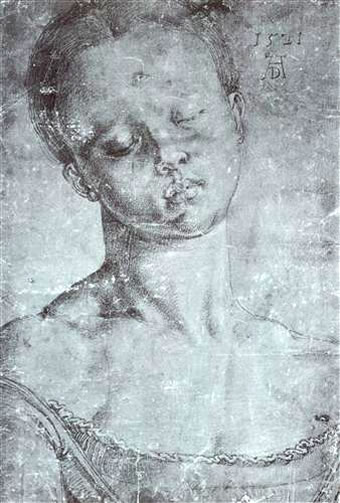 Albrecht Durer St. Barbara Chalk on green grounded paper, 1521 41,7 × 28,6 sm |
Saint Barbara: Veneration The name of Saint Barbara was known in Rome in the 7th century; her cult can be traced to the 9th century, at first in the East. Since there is no mention of her in the earlier martyrologies, her historicity is considered doubtful. Her legend is included in Vincent of Beauvais' Speculum historiale (xii.64) and in later versions of the Golden Legend (and in William Caxton's version of it). Various versions, who include two surviving mystery plays, differ on the location of her martyrdom, which is variously given as Tuscany, Rome, Antioch, Baalbek, and Nicomedia. Saint
Barbara is one of the Fourteen Holy Helpers. Her association with
the lightning that killed her father has caused her to be invoked
against lightning and fire; by association with explosions, she
is also the patron of artillery and mining. Her feast on December
4 was included in the Tridentine Calendar, having been introduced
in Rome in the 12th century. In the 12th century, the relics of Saint Barbara were brought from Constantinople to the St. Michael's Golden-Domed Monastery in Kiev, where they were kept until the 1930s, when they were transferred to St. Vladimir's Cathedral in the same city. A small part of St. Barbara's relics were brought to the United States by His Holiness Patriarch Filaret of The Ukrainian Orthodox Church Kyivan Patriarchate in November 2012, they are permanently on display for veneration at St. Andrew Ukrainian Orthodox Cathedral in Bloomingdale, Illinois. Her feast day for Catholics, Eastern Orthodox and Anglicans is December 4. The relics
of the holy Great Martyr Barbara (December 4) were transferred to
Kiev by Barbara, the daughter of the Byzantine Emperor Alexius Comnenos,
who married the Russian prince Michael Izyaslavich. They rest even
now at Kiev’s St Vladimir cathedral, where an Akathist to
the saint is served each Tuesday. |
| Saint
Barbara: Saint Barbara became the patron saint of artillerymen. She is also traditionally the patron of armourers, military engineers, gunsmiths, miners and anyone else who worked with cannon and explosives. She is invoked against thunder and lightning and all accidents arising from explosions of gunpowder. She is venerated by Catholics who face the danger of sudden and violent death in work.
Saint Barbara’s Day, December 4, is celebrated by the British (Royal Artillery, RAF Armourers, Royal Engineers), Australian (Royal Regiment of Australian Artillery, RAAF Armourers), Canadian (Explosive Ordnance Disposal Technicians (EOD), Canadian Air Force Armourers, Royal Canadian Artillery, Canadian Military Field Engineers, Royal Canadian Navy Weapons Engineering Technicians), New Zealand (RNZAF Armourers, RNZA, RNZN Gunners Branch) armed forces. Additionally, it is celebrated by Irish Defence Forces Artillery Regiments, Norwegian Armed Forces Artillery Battalion, United States Army and Marine Corps Field and Air Defense Artillery, many Marine Corps Explosive Ordnance Disposal Technicians, and other artillery formations. The
units and sub-units celebrate the day with church parades, sports
days, guest nights, cocktail parties, dinners and other activities.
Several mining institutions also celebrate it, such as some branches
of the Australian Institute of Mining and Metallurgy. The West Australian
Mining Club celebrate St Barbara's Day and use it to remember those
people who have died working in the mining industry during the year.
Although they do not celebrate her saint's day, she is also the
patron saint of US Navy and Marine Corps Aviation Ordnancemen.
St. Barbara is the patron saint of artillerymen, military engineers, miners and others who work with explosives because of her legend's association with lightning, and also of mathematicians. Many of the thirteen miracles in a 15th-century French version of her story turn on the security she offered that her devotees would not die without making confession and receiving extreme unction. |
|
| |
Prayer
to Saint Barbara
In mainstream Catholic practice, prayers for the intercession of Saint Barbara are fairly conventional and do not ask for safety from lightning or while handling ammunition or explosives. Here is a typical petition, as found on the back of a Saint Anthony holy card: Prayer
to Saint Barbara St. Barbara, Pray for Us! |
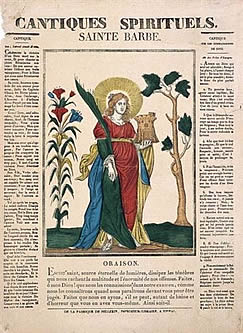 |
Prayer
in Honour of Saint Barbara
Here is another, fairly generic prayer to Saint Barbara: O
God, Who didst adorn |
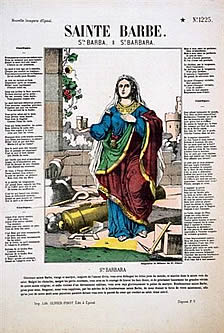 |
| Invocation
of St. Barbara This prayer invokes Barbara's legendary aid against sudden death, without soecifically mentioning the particular forms of danger against which her aid is sought. |
||
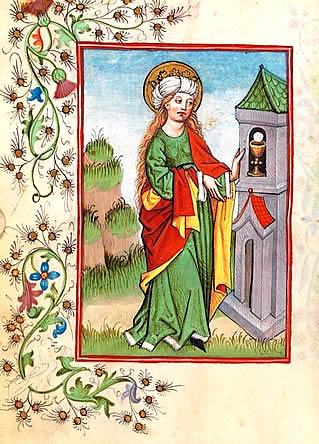 |
Intrepid
Virgin and Martyr, St. Barbara, Repel from
me all the assaults and temptations of the evil one, St.
Barbara, at my last end |
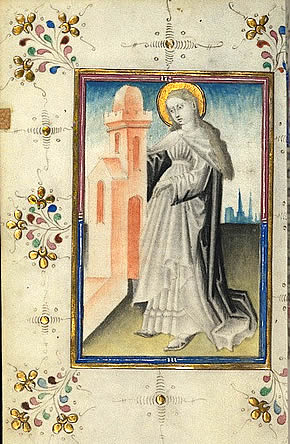 |
|
|
| Copyright
© 2004 abc-people.com Design and conception BeStudio © 2014-2023 |
